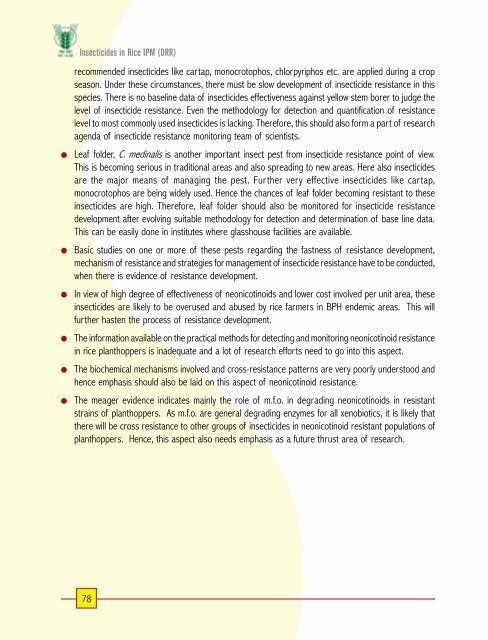priciples of insecticide use in rice ipm
priciples of insecticide use in rice ipm
priciples of insecticide use in rice ipm
You also want an ePaper? Increase the reach of your titles
YUMPU automatically turns print PDFs into web optimized ePapers that Google loves.
Insecticides <strong>in</strong> Rice IPM (DRR)<br />
recommended <strong><strong>in</strong>secticide</strong>s like cartap, monocrotophos, chlorpyriphos etc. are applied dur<strong>in</strong>g a crop<br />
season. Under these circumstances, there must be slow development <strong>of</strong> <strong><strong>in</strong>secticide</strong> resistance <strong>in</strong> this<br />
species. There is no basel<strong>in</strong>e data <strong>of</strong> <strong><strong>in</strong>secticide</strong>s effectiveness aga<strong>in</strong>st yellow stem borer to judge the<br />
level <strong>of</strong> <strong><strong>in</strong>secticide</strong> resistance. Even the methodology for detection and quantification <strong>of</strong> resistance<br />
level to most commonly <strong>use</strong>d <strong><strong>in</strong>secticide</strong>s is lack<strong>in</strong>g. Therefore, this should also form a part <strong>of</strong> research<br />
agenda <strong>of</strong> <strong><strong>in</strong>secticide</strong> resistance monitor<strong>in</strong>g team <strong>of</strong> scientists.<br />
l Leaf folder, C. med<strong>in</strong>alis is another important <strong>in</strong>sect pest from <strong><strong>in</strong>secticide</strong> resistance po<strong>in</strong>t <strong>of</strong> view.<br />
This is becom<strong>in</strong>g serious <strong>in</strong> traditional areas and also spread<strong>in</strong>g to new areas. Here also <strong><strong>in</strong>secticide</strong>s<br />
are the major means <strong>of</strong> manag<strong>in</strong>g the pest. Further very effective <strong><strong>in</strong>secticide</strong>s like cartap,<br />
monocrotophos are be<strong>in</strong>g widely <strong>use</strong>d. Hence the chances <strong>of</strong> leaf folder becom<strong>in</strong>g resistant to these<br />
<strong><strong>in</strong>secticide</strong>s are high. Therefore, leaf folder should also be monitored for <strong><strong>in</strong>secticide</strong> resistance<br />
development after evolv<strong>in</strong>g suitable methodology for detection and determ<strong>in</strong>ation <strong>of</strong> base l<strong>in</strong>e data.<br />
This can be easily done <strong>in</strong> <strong>in</strong>stitutes where glassho<strong>use</strong> facilities are available.<br />
l Basic studies on one or more <strong>of</strong> these pests regard<strong>in</strong>g the fastness <strong>of</strong> resistance development,<br />
mechanism <strong>of</strong> resistance and strategies for management <strong>of</strong> <strong><strong>in</strong>secticide</strong> resistance have to be conducted,<br />
when there is evidence <strong>of</strong> resistance development.<br />
l In view <strong>of</strong> high degree <strong>of</strong> effectiveness <strong>of</strong> neonicot<strong>in</strong>oids and lower cost <strong>in</strong>volved per unit area, these<br />
<strong><strong>in</strong>secticide</strong>s are likely to be over<strong>use</strong>d and ab<strong>use</strong>d by <strong>rice</strong> farmers <strong>in</strong> BPH endemic areas. This will<br />
further hasten the process <strong>of</strong> resistance development.<br />
l The <strong>in</strong>formation available on the practical methods for detect<strong>in</strong>g and monitor<strong>in</strong>g neonicot<strong>in</strong>oid resistance<br />
<strong>in</strong> <strong>rice</strong> planthoppers is <strong>in</strong>adequate and a lot <strong>of</strong> research efforts need to go <strong>in</strong>to this aspect.<br />
l The biochemical mechanisms <strong>in</strong>volved and cross-resistance patterns are very poorly understood and<br />
hence emphasis should also be laid on this aspect <strong>of</strong> neonicot<strong>in</strong>oid resistance.<br />
l The meager evidence <strong>in</strong>dicates ma<strong>in</strong>ly the role <strong>of</strong> m.f.o. <strong>in</strong> degrad<strong>in</strong>g neonicot<strong>in</strong>oids <strong>in</strong> resistant<br />
stra<strong>in</strong>s <strong>of</strong> planthoppers. As m.f.o. are general degrad<strong>in</strong>g enzymes for all xenobiotics, it is likely that<br />
there will be cross resistance to other groups <strong>of</strong> <strong><strong>in</strong>secticide</strong>s <strong>in</strong> neonicot<strong>in</strong>oid resistant populations <strong>of</strong><br />
planthoppers. Hence, this aspect also needs emphasis as a future thrust area <strong>of</strong> research.<br />
78











